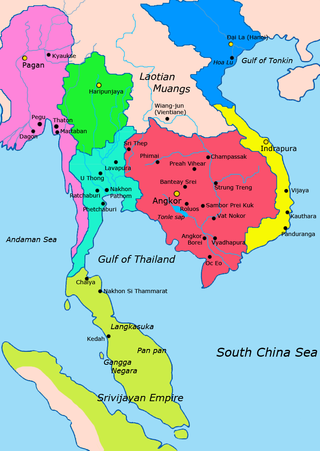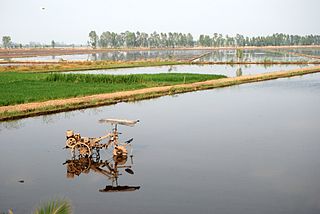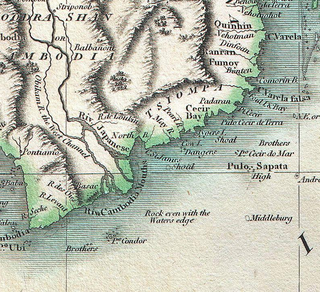
Champa was a collection of independent Cham polities that extended across the coast of what is present-day central and southern Vietnam from approximately the 2nd century AD until 1832. According to earliest historical references found in ancient sources, the first Cham polities were established around the 2nd to 3rd centuries CE, in the wake of Khu Liên's rebellion against the rule of China's Eastern Han dynasty, and lasted until when the final remaining principality of Champa was annexed by Emperor Minh Mạng of the Vietnamese Nguyễn dynasty as part of the expansionist Nam tiến policy. The kingdom was known variously as Nagaracampa, Champa (ꨌꩌꨛꨩ) in modern Cham, and Châmpa (ចាម្ប៉ា) in the Khmer inscriptions, Chiêm Thành in Vietnamese and Zhànchéng in Chinese records, and al-Ṣanf in Middle Eastern Muslim records.

The Mekong Delta, also known as the Western Region or South-western region, is the region in southwestern Vietnam where the Mekong River approaches and empties into the sea through a network of distributaries. The Mekong delta region encompasses a large portion of south-western Vietnam of over 40,500 km2 (15,600 sq mi). The size of the area covered by water depends on the season. Its wet coastal geography makes it an important source of agriculture and aquaculture for the country.

Mỹ Sơn is a cluster of abandoned and partially ruined Shaiva Hindu temples in central Vietnam, constructed between the 4th and the 14th century by the Kings of Champa, an Indianized kingdom of the Cham people. The temples are dedicated to the veneration of God in accordance with Shaivism, wherein God is named Shiva, or The Auspicious One. In this particular complex, he is venerated under various local names, the most important of which is Bhadreshvara.

Princess Huyền Trân (1289-1340) was a princess of the Trần Dynasty of Đại Việt, who later married to King Jaya Simhavarman III of Champa and titled queen consort Parameshvari of Champa from 1306 to 1307.
Jaya Simhavarman III, Chế Mân (制旻), or Prince Harijit, son of King Indravarman V and Queen Gaurendraksmi, was a king of Champa during a time when the threat of the Mongols was imminent. He held the title the half-king/junior king (arddharāja) on behalf of his father.
Jaya Paramesvaravarman II, born Prince Angsaraja of Turai-vijaya, was the king of Champa from 1220 to 1254. He was the grandson of Jaya Harivarman I, but was raised in the court of Jayavarman VII. He attained the rank of Yuvaraja in 1201, led the Khmer Empire's attack on Dai Viet in 1207. Following the Khmer voluntary evacuation of Champa in 1220, in 1226, Angsaraja took a coronation ceremony (abhiseka) at the city of Vijaya, declaring his regnal name of Jaya Parameśvaravarman "reign with the single parasol over the state of Champa."
Jaya Indravarman IV was the king of Champa, a former region located within modern-day Vietnam, from 1167–1192. He probably was the same person as Panduranga ruler, Po Klong Garai. A usurper, "he called himself Jaya Indravarman on Vatu and said he came from the 'famous place known by the name Gramapuravijaya." He was "full of energy, courage and pride...well versed in all the shastra." He sent tribute to the Court of China and the Dai Viet. Unsuccessful in purchasing horses from China for an overland invasion, he prepared a squadron of water vessels.

Indrapura was the capital city of the kingdom of Champa from 875 AD until 982, or until 12th century AD. It was built and ruled under the reign of Buddhist king Indravarman II and some of his successors belonging to the Bhrgu dynasty in Đồng Dương. The word Indrapura means "City of Indra" in Sanskrit, Indra being the Hindu God of Storm and War, and King of the Gods in the Rig Veda.
The history of Champa begins in prehistory with the migration of the ancestors of the Cham people to mainland Southeast Asia and the founding of their Indianized maritime kingdom based in what is now central Vietnam in the early centuries AD, and ends when the final vestiges of the kingdom were annexed and absorbed by Vietnam in 1832.

Panduranga or Prangdarang was a Cham Principality. Panduranga was the rump state of the Champa kingdom after Lê Thánh Tông, emperor of Đại Việt, destroyed Champa in 1471 in retaliation for centuries of Cham invasions and piracy. The Panduranga principality was located in present-day south-central Vietnam and its centre is around the modern day city of Phan Rang. It stood until late 17th century when the Nguyễn lords of Đàng Trong, a powerful Vietnamese clan, vassalized it and subjugated the Cham polity as the Principality of Thuận Thành.

Khmer–Cham wars were a series of conflicts and contests between states of the Khmer Empire and Champa, later involving Đại Việt, that lasted from the mid-10th century to the early 13th century in mainland Southeast Asia. The first conflict began in 950 AD when Khmer troops sacked the Cham principality of Kauthara. Tensions between the Khmer Empire and Champa reached a climax in the middle of the 12th century when both deployed field armies and waged devastating wars against each other. The conflicts ended after the Khmer army voluntarily retreated from occupying Champa in 1220.

The Champa–Đại Việt War (1367–1390) was a costly military confrontation fought between the Đại Việt kingdom under the ruling Trần dynasty and the kingdom of Champa led by the King of Chế Bồng Nga in the late 14th century, from 1367 to 1390. By 1330s, Đại Việt and Khmer Empire both felt into swiftly declining due to climate changes, population expansion, widespread bubonic plague, famines and many other factions, which contributed to Champa's resurgence of the 14th century. In 1360, Chế Bồng Nga, son of king Chế A Nan was enthroned as king of Champa, reunited the Chams under his banner, and in 1367 he demanded Trần Dụ Tông the return of two former provinces Ô and Lý to Champa. Declined to this demand, Trần Dụ Tông sent an army to strike Champa but was repulsed.

Vikrāntavarman II, was the seventh king of the Fourth dynasty of Champa, modern-day Central Vietnam, reigned from 686 to 741. He was the son of king Vikrantavarman I. He was identified as Jianduodamo in the medieval Chinese annals of the New Book of Tang. In his kośa for the lingam of Vāmeśvara in Mỹ Sơn, Vikrantavarman II is venerated as lion among kings.
Jaya Satyavarman, was the second king of the Fifth dynasty of Champa, modern-day Central Vietnam, reigned from 770 to 787. He was the nephew of king Prithindravarman, founder of a dynasty that centralized around the southern part of Champa.
Rudravarman IV (?–1147) was a king of Champa during the mid-12th century, at mid of the Angkor invasions of Champa. Rudravarman however has never reigned.
Harivarman II, was king of Champa from 988 to 997.
Jaya Paramesvaravarman I, personal name Īśvaramūrti, was a king of Champa, reigning from 1044 to 1060. He founded a dynasty that centralized around Nha Trang and Phan Rang, which would dominantly rule mandala Champa until 1074.
Harivarman IV or Prince Thäng (?–1081), Sanskrit name Vishnumürti, was the ruling king of Champa from 1074 to 1080. His father was a noble belonging to the Coconut clan, and his mother was a member of the Areca clan.
Tribhuvana Mahadevi or Tribhuvanadevi was a Cham female leader and queen of Champa, the chief wife of king Jaya Simhavarman I.
Paramabhodhisatva was a king of Champa, reigning from 1081 to 1086. He usurped power from his nine-year-old nephew Jaya Indravarman II in 1081 shortly after his succession.









